6 Cats with Curly Ears – Why the curly ears?
Curly ears on cats!? Hmm…
Curved ears breeds and their characteristics
The traditional cat we all know and draw as children have upright, triangular ears. The shape and size vary slightly from one cat to another. Some grow to have larger, flared ears while some develop small, rounded or pointed ears.
Have you seen the curled/folded versions of some cats!? Unusual and cute-looking, some cat breeds present ears with mild curls or tight folds. Let’s see what causes the intriguing shape and what cat breeds carry them.

Why do some cats have curly ears?
The size, shape, and position of ears differ among cats. You can find small-eared cats, bat-like large ears, wide and flappy or close together at the top of the head. Some have rounded tips while others have pointed one, tufted, hairless or folded inwards or outwards.
In curl-eared cats, the main cause is a genetic mutation. The specifics of the mutation depend on the cat breed and the particular ear shape. There are two widely known types of curved ears: curled to the outside and folded inside.
The outward curl comes from a spontaneous mutation that causes no additional health problems. The folds, though, are caused by a gene mutation that brings about bone and cartilage issues in the cats.
The charm of curved ears together with the cute features of a cat have pet owners hooked. But as lovely as these cats are, we need to remember that health is more important. After all, we are dealing with a mutation and your cat might suffer from the shape of the ears.
Do cats with curved ears have health problems?
Not always, but it is a big factor. Depending on the breed of your cat, a curled ear shape can come with consequent issues.
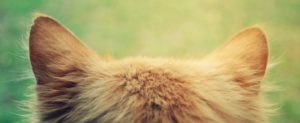
Folded ears
The most popular cat is the Scottish Fold. These cats grow ears folded inwards, some more tightly than others. The distinctive folded ears are caused by an incomplete dominant gene. This makes the ear cartilage curl and gives the impression of no ears on a round head.
In Scottish Folds, the mutation affects the cartilage and bones further. Many cats from this breed develop a joint disease, tail and legs stiffness. In time, their mobility decreases and it becomes more painful. Because of this, breeders only cross Folds with non-Folds to avoid some of the medical problems.
![]()
If your Scottish Fold is healthy and well, the ears still need attentive grooming. Because of the tight fold, regular cleaning to remove wax and dirt is essential. The ear needs to be gently unfolded and cleaned.
Curled ears
In the curly ears section, the widest spread breed is the American Curl. A spontaneous mutation when breeding caused the ears to curl back.
Unlike the Scottish Fold, these cats are generally healthy. The mutation responsible for the quirky shape of the ears does not spread to the rest of the body.
However, their ears are quite sensitive. After curling, the cartilage hardens and leaves the ears stiff. Rough handling can damage the structure and cause pain.

There is no clear data on the implications on the American Curl, but the ears might also present narrowed canals. This means that grooming of the ears is important. You need to check them weekly and clear the dirt and debris. The back curl leaves the ears more exposed than your average cat and prone to infections.
Cat breeds with curved ears
History gave us a lot of experiments on breeding and passing on specific traits. When it comes to the curly ears, they resulted from unplanned mutations along the way.
Reports of cats with folded ears appeared in Germany and Belgium. Yet, they never made much fuss and were seen as isolated cases or curiosities. But some crossings have been passing along the mutation for decades.
Scottish Fold
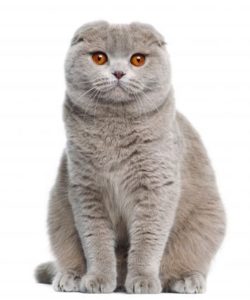
Scottish fold cat
The ancestor of this breed is a farm cat named Susie. Back in Scotland, Susie passed on her owl-like ears to her kittens. In 1966, the owner started a breeding program and tried to register it. Of the 76 kittens born in the program, 42 grew folded ears and 34 had straight ones. This is when it became clear that a dominant gene is responsible.
Because of the related health problems, the breed was not accepted in Europe. Cats would develop limb problems, deformities, mobility problems, arthritis, mites, infections, and even deafness.
In the present, due to selective breeding, some of the issues disappeared. Still, Scottish Fold builds up wax in their tight ears more than other cats.
Characteristics
Body & coat – Medium-sized cat with a round body shape, large eyes, short nose, and medium legs. Ears give them away and make them very popular. The coat can be short or long-haired and very dense with all kinds of color combinations.
Personality – Affectionate and family friendly. Moderately active, intelligent and likes to play with puzzle & teaser toys. Gentle voice with a wide array of sounds, but most of the time quiet. Sits in funny and one-of-a-kind positions. The Buddha pose is a Scottish Fold trademark and sleeping on the back with paws up.
Health – 15 years lifespan. Prone to a degenerative joint disease that can cause pain, poor mobility, stiffness. Also susceptible to kidney disease and cardiomyopathy.
Grooming – They need moderate grooming. Weekly brushing of short-haired cats and twice a week for the ones with long hair. Trim the nails and wipe their eyes for discharge on a regular basis. Ears need some special attention. You need to gently unfold them and check for dirt or infections. Clean them with a damp cloth and warm water, avoiding cotton swabs that could damage the ear.
Fun fact: Scottish Folds are born with straight ears that start to fold after ~21 days. There are variations, some grow up to have straight ears while some fold forward.
American Curl
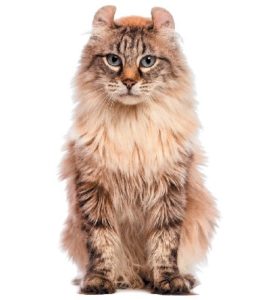
American curl cat
This breed originated in California after a spontaneous mutation. In 1981 a black female cat gave birth to kittens with the same curled-back ears. It became a pedigree breed quite fast. In 1987 they were recognized by the International Cat Association.
Because of their large gene pool, they can be bred with other American Curls or crossed with different cats.
Characteristics
Body & Coat – Like the Scottish Fold, they are medium-sized cats weighing between 2.5 and 5 kg (5-10 pounds). They are strong cats with a sweet expression. Their ears are curled back in an arc and the ear tufts make them adorable. A show cat needs to have a curl that describes a 90-degree arc and no more than 180 degrees. The tips are round and flexible. Coats can be long or short-haired and colored in any way possible.
Personality – They are friendly and love the company of people. Moderate activity, curious and intelligent. They follow you around, bump their heads for affection and like to play fetch. Younger cats will be more active than the older ones.
Health – They are strong cats in good health with a lifespan of 12-16 years. Depending on the breeding, some may have small genetic problems, but nothing serious. The curled ears, however, are quite sensitive, with narrow ear canals and a lot of wax build up. That can cause infections, but proper care can prevent it.
Grooming – Depending on the coat type, the grooming is not exhausting. Regular brushing to untangle the hair and remove dirt is enough. The longer haired ones could benefit from daily brushing though. Ears need constant cleaning to prevent infections. The curl back exposes the ear more and the narrow canal can retain debris and wax. It is important to handle the ears with care, they are fragile and you could easily damage the cartilage.
Fun fact: when born, the kittens have straight ears and begin to curl after 2 days. After the first 4 months of life, the ears stop curling and become stiff with flexible tips.
Highlander
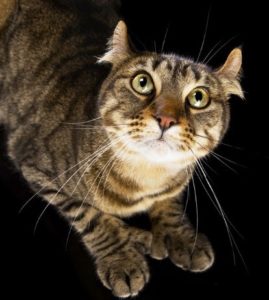
Highlander cat
The origin of this breed comes from a deliberate crossing between the Desert Lynx and the Jungle Curl. The curled ears have been passed on with intention from the Jungle Curl as the name suggests.
Also known as the Highlander Shorthair or the Highlander Lynx, the first breeding dates back to 1993. At first, it was included in a breeding group. Gradually, the Highlander breed was refined. In 2008 the International Cat Association recognized it for competition.
Characteristics
Body & Coat – although the name aims and physical traits aim to a wildcat, the Highlander is a domestic, sweet cat. Medium to large-sized cat with a strong, muscular body. They can reach up to 9 kg (20 pounds), comparable to the Main Coon.
They grow bob or short tails, have a blunt muzzle and a wide nose. The distinctive ears grow upright with a curl and turn backward.
They come in short or long hair versions with coats in a variety of colors. They sometimes have spotted patterns that give them a lynx look.
Personality – Despite their size, the cats are fond of humans, friendly and playful. They are active, smart and easy to train. Provide them with toys as an outlet for all that energy, confidence and acrobatic skills. They love water which sets them aside from the average cat. Running water fascinates them and getting wet is no problem whatsoever.
Health – They have a lifespan of 10-15 years and are extremely healthy cats. They reach full maturity at 3 – 4 years of age when their body is fully grown, big and strong.
Grooming – The short-haired kind requires little grooming. An occasional brushing to remove loose fur and get rid of the dirt should do the trick. The ones with longer hair would benefit from regular, more often brushing. A good advice is to start brushing them from an early age. They will tolerate the habit better and their coat will grow healthier. Ear cleaning is important like to all other curly eared cats. Their rich ear tufts though make a good job protecting them from dirt and infections.
Fun fact: their ears are straight at birth and start to curl back over the course of two weeks. Also, Highlanders are sometimes born with polydactyl paws which makes them good grabbers. Keep your wallet closed!
Ukrainian Levkoy
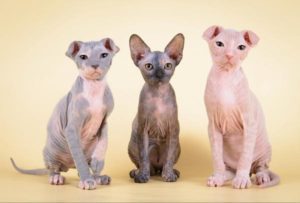
Ukrainian Levkoy cat
This is a recent breeding from Ukraine, not yet recognized internationally. The cats resulted from breeding hairless Donskoy females with Scottish Fold males. Ta-da, we’ve gotten ourselves a hairless, strong cat with folded ears. Russian and Ukrainian clubs recognize the breed and use it in competitions.
Characteristics
Body & Coat – Medium-sized cat with a long, slender body, but muscular. Their skin is elastic and forms mild wrinkles. The ears fold inward much like the Scottish Fold parent. The head is long and flat with prominent cheekbones. Long legs and an arched back line make it look elegant in posture. The ears are wide apart, large and round with a fold forward.
Personality – Playful, friendly and intelligent. They like to spend time with humans and fit well within families and other pets. They are sociable despite the apparent look. Many people want the adorable ball of fur around them, but this cat is an awesome companion.
Health – With a lifespan of 12 to 15 years, this breed is a strong cat weighing around 4 – 6 kg (8-12 pounds). The mutations from their parents may cause bone issues like arthritis.
Grooming – The lack of fur gets you off the hook with brushing. In exchange, they need skin care and protection from direct sun exposure or cold temperatures. Ears need tending and cleaning.
Foldex
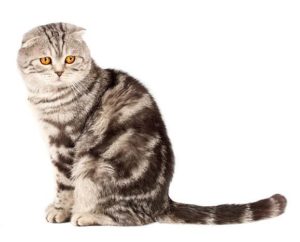
Foldex cat
The origin of this kitty goes all the way to Canada. They are also called Exotic Folds and they have been bred from a Scottish Fold and an Exotic Shorthair.
Characteristics
Body & Coat – The crossing resulted in a cat with a mild fold of the ears. The face is well rounded with big eyes similar to the Scottish Fold parent.
The body is medium-sized, round and with short legs. They weight anywhere around 3-6 kg (6-14 pounds), have strong muscles, but a rather short neck.
The coat can be either short or long, dense and plush. Colors and patterns vary greatly with pointed, tabby or calico combinations.
Personality – They love being petted, are affectionate and don’t shy away from strangers. They are active, curious, confident and intelligent.
Grooming – Depending on the hair length, they will need constant brushing to prevent tangles and fur balls. Trimming of the nails, ear, and teeth cleaning will keep your Foldex healthy.
Fun fact: their ears have a single fold downwards to the head as opposed to the double or triple fold of the Scottish.
Elf Cat
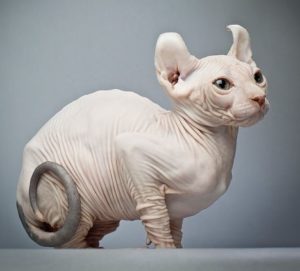
Elf cat
The Elf cat is a new and rare breed that was born from the Sphynx and the American Curl. You’ve guessed it! It is a hairless cat with back-curled ears.
Characteristics
Body & Coat – They are medium-sized, athletic and muscular cats. The cheekbones are well defined and the skin is clearly wrinkled. The ears and lack of hair are the distinctive traits of the Elf cat. Colors and patterns are plenty on this one.
Personality – Intelligent, out-going and affectionate. They can be both active and gentle. They love toys as well as the company of other pets. Leaving them home alone doesn’t bow well with them.
Health – They are remarkably healthy, with no genetic defects. Yet, the outdoors is not a good call for them. Sun exposure and cold weather can damage their skin.
Grooming – Although hairless, it is necessary to groom. The skin needs cleaning and protection to prevent skin problems. Sponge baths are a good idea, especially since they tolerate water quite well.
Looking to get yourself an unusual looking cat? Curly ears are no common trait and this list can help you make a choice. Sure, it is not an exhaustive selection, but you can start your research here.
Whatever your motivation to adopt a cat with curved ears, make sure to tend to their special needs. Cuteness is not all and their subsequent health problems will need devotion and care.